
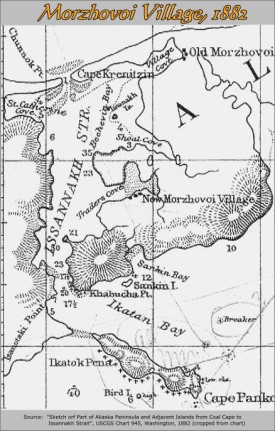
Morzhovoi village is shown on the 1882 map, on the eastern side of Isanotski Strait near the end of the Alaska Peninsula. Morzhovoi was moved several times by the Russians and probably came into being in its present location about 1830, apparently with the name of Protassof. Because of the destruction and violence during the early Russian period, many Aleut villages were abandoned and the population declined dramatically. The population movement was in general from the northern and western sides of Unimak Island towards the ancient village of Qaxatix (called Morzhovoi, or "Walrus", by the Russians). But there was only one family left at Morzhovoi in 1900 as more people moved to New Morzhovoi. New Morzhovoi's location on Trader's Cove (Protasovskaia Bukhta) had a good anchorage for the Russian sailing vessels that were needed to service the Russian-American Company employees and trading post located there.2
The present day Morzhovoi village site is pictured below. The location of the Orthodox Church is maked with a "C". Most probably the buildings with square traces were built by Russians and later affluent sea otter hunters and traders. The more oval pits were most likely "barabara" type dwellings for residents. The structures that are still standing belonged to the last residents who emigrated to False Pass in the early 1960's, when the village was finally abandoned.
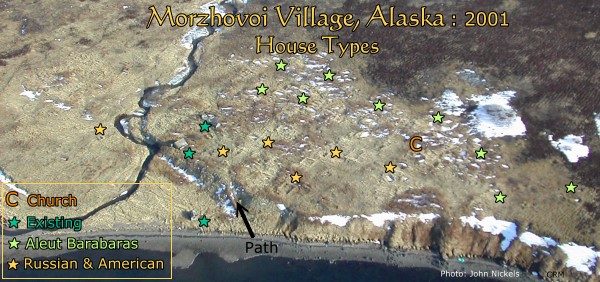
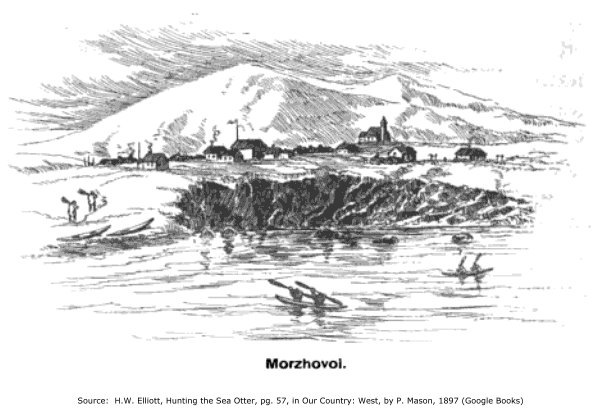
Report of the U.S.S. Albatross, 1895: "The settlement of Morzhovoi village consists of 34 males aud 40 females, of native blood, and 6 whites. Several low frame houses, the property of the Alaska Commercial Company, a Greek frame church, and a number of barabaras constitute the dwellings. The village is situated on a low sloping bluff, terminating in a rocky and gravelly spit on the south shore of the cove. Bear, fox, and otter hunting are the principal occupations. .... Like all other villages in Alaska, the occupations of the people are fishing and hunting. Nine bidarkas, carrying two men each, started out in the spring of 1894, and at the time of our visit had only captured nine sea otters, one to each bidarka. The people here predict that, in a few years at the most, sea otter will be exterminated, or so nearly so that it will not pay to hunt them. ..." 5
Morzhovoi village today has been mostly reclaimed by the tundra. The old church has been down for many years and the church's icons and valuables have been moved to the King Cove church. The bronze church bells that were cast in St. Petersburg and that once hung outside were stolen by crab fishermen in the late 1970's.
The view of the village site from near the old church location shows a wind generator tower located next to the old Shellikoff house. In the distance can be seen the lagoons that occupy the eastern and northern end of Trader's Cove, where pink salmon often spawn in abundance.
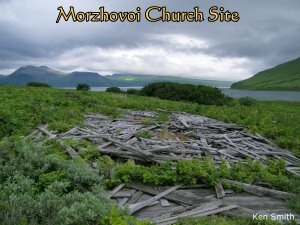
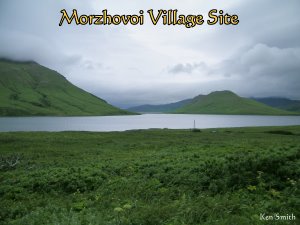

Morzhovoi in 1897 had a population that included Aleuts born in many other villages in the Aleutian area. There were also four northern European men settled here that had married Aleut women. The magnet that drew all these people to Morzhovoi was primarily the hunting of sea otters and the Aleuts' need for money in the new commercial economy. During the Russian period, sea otter hunting was carefully controlled by the Russian American Company. But, after the acquisition of Alaska by the Americans, sea otters were hunted intensively until the otter population crashed right after 1900. Since this time period coincided with a flood of immigrants from Europe to the U.S., many of these new immigrants went directly to Alaska to take part in the great American frontier where fortunes could be made quickly hunting sea otters. Aleuts, who had traditionally hunted sea otters throughout the Aleutian Islands knew that the best hunting grounds were located near the Sanak and Unimak Islands, and Morzhovoi was well located to take up the lucrative hunt.
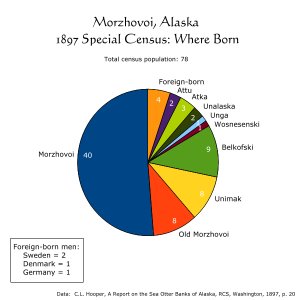
A U.S. government report in 1890 states: " At the western extremity of the Alaskan peninsula, in a cove opening into .... Issanak strait, there is a native settlement inhabited by about 60 Aleuts, who make a good living in hunting sea otters on both sides of the peninsula, and trapping foxes and land otters on their own shore and on Unimak island. Both bears and reindeers are numerous here, and food fishes exist in the usual abundance. Morzhovoi has a good trading store, and has also been selected as headquarters by a number of white sea-otter hunters owning several smart schooners, which skip in and out through the shallow and intricate northern entrance of the strait, which is practically impassable for larger craft and skippers not possessed of the most intimate local knowledge."1
The population of Morzhovoi peaked in 1880 and stayed relatively high until the end of the 19th century. This was at the time that the hunting of sea otters was providing lucrative returns to the hunters and traders. By 1910 the sea otters had been exterminated locally and hunting was made illegal by international treaty. The result was that there was a dramatic exodus of people from Morzhovoi, cutting the population by slightly more than half.
The population stabilized through 1920, supported in large part by the trapping of other fur-bearing animals such as fox, river otter and wolf. The trapping period ended around 1940 by which time the population of Morzhovoi had declined to only 17. That was the last official census but a few people continued to live there until final abandonment of the village in the early 1960's. Click on graph to see larger version.
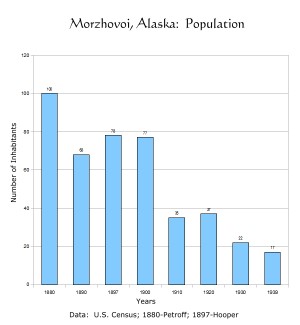
In 1897 a report on the Sea-Otter banks of Alaska stated:
"MORZHOVOI. This district was hunted by the inhabitants of the settlement of that name in Isanotski Strait or False Pass. The hunting ground embraces the banks and reefs in the vicinity of the pass on the Pacific side, the pass itself in which during Russian times many thousands were taken, and the banks in Bering Sea between Cape Lapin, Unimak Island, on the southwest, and Amak Island on the northeast. For many years the Morzhovoi natives have used both gun and spear. This ground is nearly hunted out, and a large part of the skins credited to it during the past ten years were taken on the Kadiak grounds by Morzhovoi hunters." 3
The 1900 census shows the blending of Aleuts and foreign-born immigrants. During Russian times, non-Aleut immigrants were not permitted to live in the villages and only the Russian employees of the Russian American Company were allowed. But, after 1867 when the U.S. bought Alaska from Russia, the whole immigration policy changed and immigrants began to arrive mostly from northern Europe to live in the Aleut villages. The U.S. law for protecting sea otters also stated that sea otters could only be hunted by Aleuts, but that caucasian males married to Aleut women could legally hunt. This brought in a number of northern European immigrants to Morzhovoi to marry Aleut women and take part in the lucrative sea otter harvest. Also, during this time the trading of pelts was controlled mostly by the Alaska Commercial Company and the trading post in Morzhovoi was run by its employee, William Brown in the early 1990's and later by B. Benson.3,6
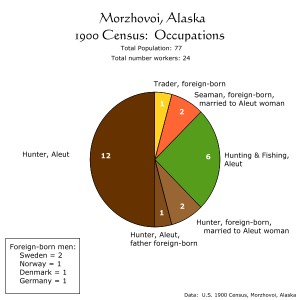
Morzhovoi church built: "Another neat chapel costing nearly $1,000 was erected by the sea-otter hunters of Morzhovoi or Protassof settlement." 4
Morzhovoi village: "...This place contains nearly 100 people, who are successful sea-otter hunters, securing an average of 500 skins every year. These people are equally opulent and extravagent as their neighbors in Belkovsky.... an average annual revenue of nearly $1,000 to each family.... Not far from Morzhovoi walrus can be secured but with little difficulty... The old men and youths not absorbed by the sea-otter parties, trap foxes all over the mountains and rolling plains and shoot a bear occasionally, while the women are busily engaged in collecting driftwood and brush, the only fuel in the country." 4
The 1910 census for Morzhovoi shows the consequences of the collapse of sea otter hunting on the local population. There was an exodus of people from the village and the population declined by over one half, from 77 to 34. It appears that all the non-Aleut immigrants left for better employment elsewhere. Since there is no mention of a trader, it appears that the trading post was also closed by this time. Up until this time, the hunting of sea otters had provided most of the income for the local economy. Now, the emphasis shifted to trapping the other wild fur bearing animals of the area, fox, land otter, wolf and wolverine.
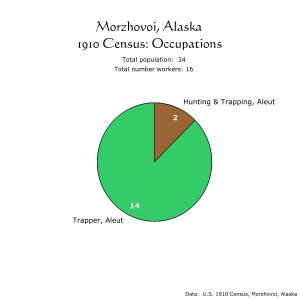
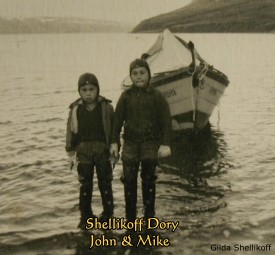
Travel to and from Morzhovoi was usually done via dory. These dories often had a tarp covering that kept the passengers and cargo dry and made it very sea worthy.
The 1920 Morzhovoi census included people who were actually residing in and around False Pass because False Pass did not have an official post office until 1921. Therefore, the actual Morzhovoi population in 1920 was 37.
The new salmon cannery in False Pass had its first salmon pack in 1920 and this graph shows that 5 people worked for the False Pass cannery and they lived in the False Pass area. At this time, people in Morzhovoi were not yet working in the False Pass cannery. Rather, the local economy depended upon trapping the surrounding country for fur animals.
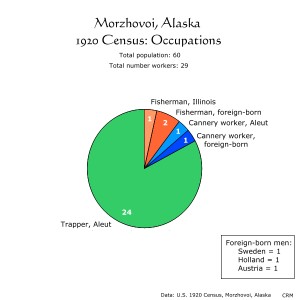
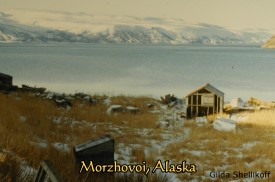
Morzhovoi village, looking northwest towards Isanotski Strait. This area on the beach is where the dories and skiffs were brought up. The old skiff "bone yard" is visible on the left. The building was the Shellikoff work shop.
At the 1930 census, Morzhovoi continued to decline in population. Although the trapping of furs still provided income for 8 workers, there apparently was not enough income to keep people from leaving the community.
By this time, one local man was working in the False Pass cannery, probably spending the summers there and the winters in Morzhovoi. Also this was the time when John Hodiakoff was fireman on the steamship, Starr.
By the end of the 1930's the fur trapping business was in steep decline and the population of Morzhovoi had to depend upon working for the cannery in False Pass. Even with that income, the population continued to decline.
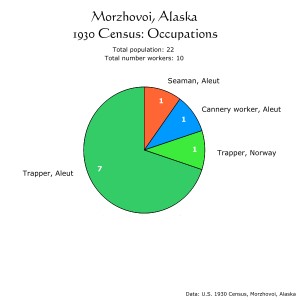
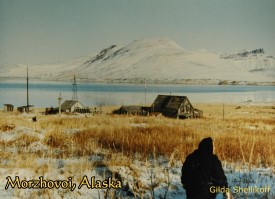
The photo above shows Morzhovoi Village in wintertime. Nellie Shellikoff stands above the Shellikoff house with the Zakhar Dushin house just beyond the wind generator tower.
The 1940 census for Morzhovoi shows the continuing decline in population. By this date the market for furs had collapsed so that the trapping of fox which had been the mainstay of the local economy had to be abandoned. This meant that the only source of employment for local people was in the commercial fishing and processing of salmon, focussed on the cannery in False Pass. Some of the Morzhovoi people temporarily moved to False Pass during the salmon season to be able to work and fish for the cannery.The U.S. census does not record any data for Morzhovoi after 1940, even though some families continued to live there. In 1951 Nick Bez stationed a floating salmon processor, the Cape Douglas, off Morzhovoi village and processed salmon there. Bez later bought the P.E. Harris cannery in False Pass.
The last inhabitants of Morzhovoi, the Shellikoffs, moved to False Pass in the early 1960's.
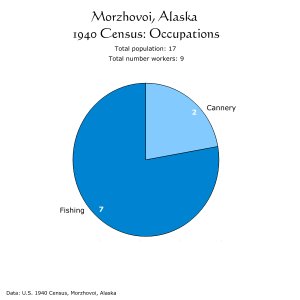
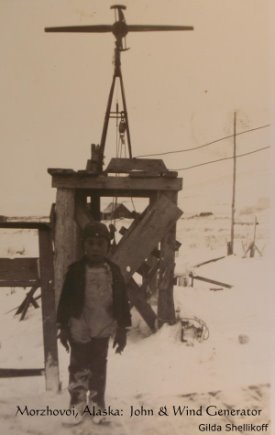
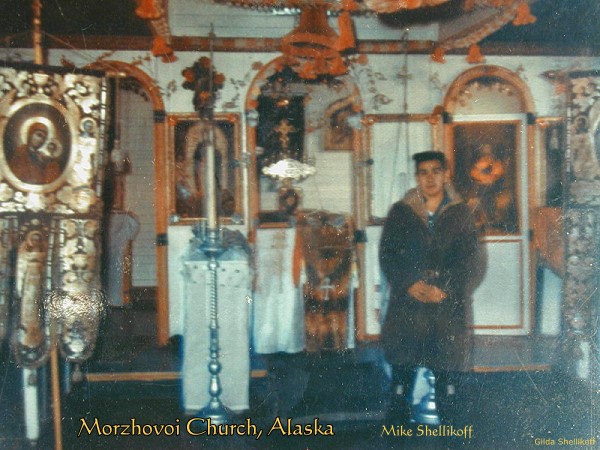
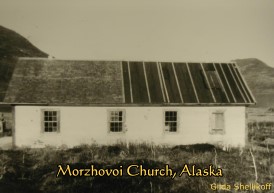
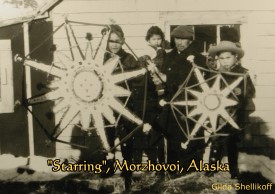
"Starring" at Morzhovoi Village: Mike, John, William Shellikoff & Zakhar Dushkin
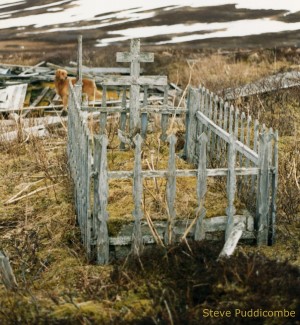
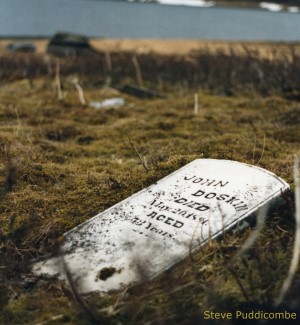
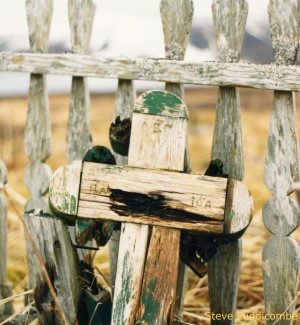
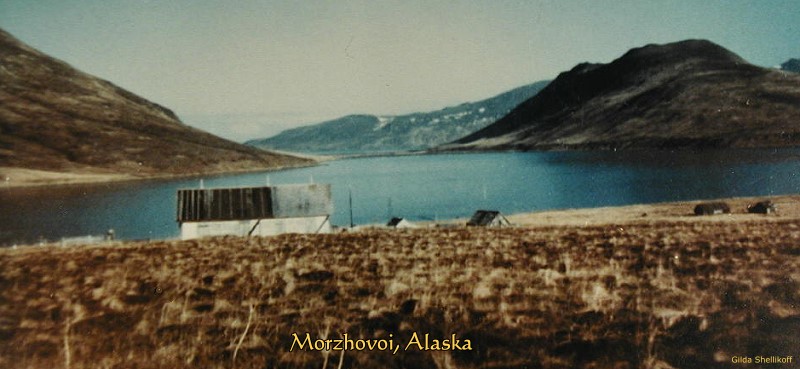
Morzhovoi village, looking north. The Russian Orthodox Church and cemetery are shown on the left. The houses below the church in the center, belonged to Zakhar Dushkin and Nellie Shellikoff. The cabins on the right belonged to Johnny "Papoose" Garasmoff and the Fergusons.
References:
1) Report on population and resources of Alaska at the eleventh census, 1890 (Google eBook), USGPO, Washington, 1893, pg. 87
2) Black, Lydia T., History and Ethnohistory of Aleutians East Borough, Limestone Press, 1999, False Pass chapter. pg 163-
3) Hooper, C.L., A Report on the Sea-Otter Banks of Alaska, USGPO, Washington, 1897
4) Report on population and resources of Alaska at the eleventh census, 1890, USGPO, Washington, 1893, pg. 182
5) U.S. Commission of Fish and Fisheries, Report of the Commissioner for year ending June 30, 1895, Washington, GPO, 1896, pg. 142
6) U.S. Census, Morzhovoi, Alaska, 1900.